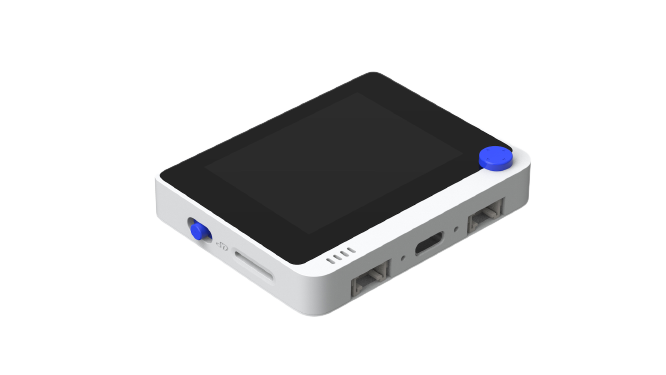Wio Terminal
Overview
The Wio Terminal is a small (72 mm x 57 mm x 12 mm) and powerful ARM board with wireless connectivity (2.4G/5G dual-band Wi-Fi and BLE 5.0), LCD display, USB C port, FPC connector, microSD card slot, Raspberry Pi compatible 40-pins header and 2 Grove connectors.

Hardware
ATSAMD51P19 ARM Cortex-M4F processor at 120 MHz
512 KiB flash memory and 192 KiB of RAM
4 MiB external flash
MicroSD card slot
RTL8720DN 2.4G/5G Dual Bands Wireless and BLE5.0 Combo Module
2.4inch LCD display
LIS3DH accelerometer
Microphone 1.0V-10V -42dB
Speaker ≥78dB @10cm 4000Hz
Light Sensor 400-1050nm
Infrared Emitter 940nm
GPIO 40 pin (Raspberry Pi compatible)
2x Grove connectors
1x user LED
3x user buttons
5-way user button
Power/Reset/Boot mode switch
Native USB port
Supported Features
The wio_terminal board configuration supports the following hardware features:
Interface |
Controller |
Driver / Component |
|---|---|---|
NVIC |
on-chip |
Nested vector interrupt controller |
Flash |
on-chip |
Can be used with LittleFS to store files |
SYSTICK |
on-chip |
Systick |
WDT |
on-chip |
Watchdog |
GPIO |
on-chip |
I/O ports |
USART |
on-chip |
Serial port |
I2C |
on-chip |
Inter-Integrated Circuit |
SPI |
on-chip |
Serial Peripheral Interface port |
TRNG |
on-chip |
True Random Number Generator |
HWINFO |
on-chip |
Unique 128 bit serial number |
RTC |
on-chip |
Real-Time Counter |
USB |
on-chip |
USB device |
PWM |
on-chip |
PWM |
Other hardware features are not currently supported by Zephyr.
The default configuration can be found in the Kconfig file boards/seeed/wio_terminal/wio_terminal_defconfig.
Zephyr can use the default Cortex-M SYSTICK timer or the SAM0 specific RTC.
To use the RTC, set CONFIG_CORTEX_M_SYSTICK=n and set
CONFIG_SYS_CLOCK_TICKS_PER_SEC to no more than 32 kHZ divided
by 7, i.e. no more than 4500.
Connections and IOs
The Wio Terminal Getting started guide [1] has detailed information about the board including pinouts [2] and its schematics [3].
System Clock
The SAMD51 MCU is configured to use the 32.768 kHz internal oscillator with the on-chip PLL generating the 120 MHz system clock.
Serial Port
Zephyr console output is available using the USB connector, which is used to make the console available on PC as USB CDC class.
USB Device Port
The SAMD51 MCU has a USB device port that can be used to communicate with a host PC. See the USB device support samples sample applications for more, such as the USB CDC-ACM sample which sets up a virtual serial port that echos characters back to the host PC.
Programming and Debugging
The Wio Terminal ships with an UF2 bootloader that is BOSSA compatible. The bootloader can be entered by quickly tapping the reset button twice.
The UF2 file is generated when building the application, and it is possible to use it to flash the target. Enter the bootloader by quickly sliding the power button twice, and copy the UF2 file to the USB mass storage device. The device reboots on the new firmware after the UF2 file has finished transferring.
Flashing
Build the Zephyr kernel and the
buttonsample application:west build -b wio_terminal samples/basic/button
Swipe the reset/power button down twice quickly to enter bootloader mode
Flash the image:
west build -b wio_terminal samples/basic/button west flash
You should see the blue (user) LED flashing whenever you press the third (counting from the top left) user button at the top of the Wio Terminal.
Debugging
In addition to the built-in bootloader, the Wio Terminal can be flashed and debugged using an SWD probe such as the Segger J-Link.
Solder cables to the
SWCLK,SWDIO,RESET,GND, and3V3pins. See Test with SWD [4] for more information.Connect the board to the probe by connecting the
SWCLK,SWDIO,RESET,GND, and3V3pins on the Wio Terminal to theSWCLK,SWDIO,RESET,GND, andVTrefpins on the J-Link [5].Flash the image:
west build -b wio_terminal samples/basic/button west flash -r openocd
Start debugging:
west build -b wio_terminal samples/basic/button west debug
